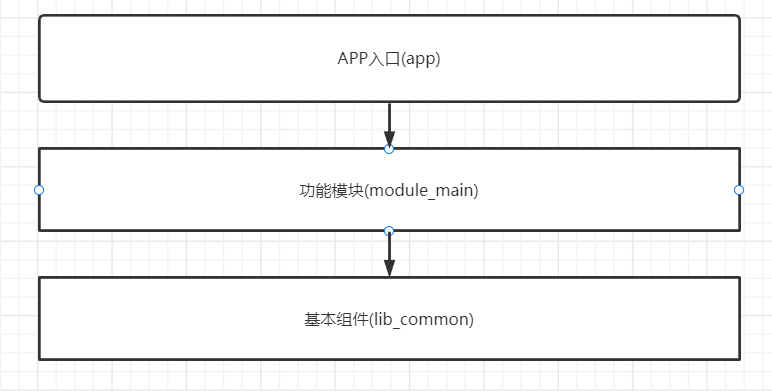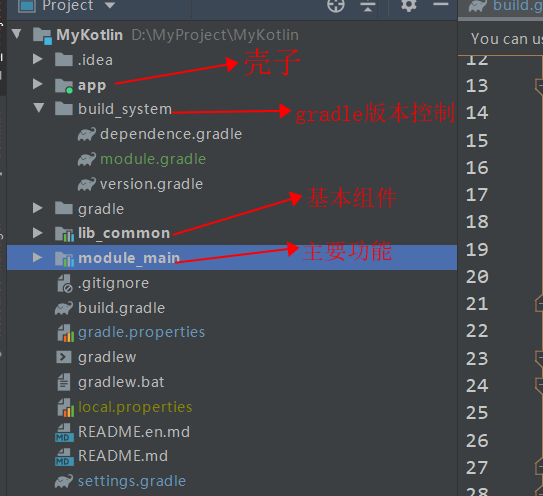Android 组件化架构
Android 组件化架构
1、组件化优势
- 编译块
- 模块之间耦合度降低
- 提高代码复用率
- 提高开发效率
2、组件结构
(该结构基于我 demo 仅供参考)

2.1、基本组件
基础模块,封装基本View,第三方SDK,网络访问框架等
2.2、功能模块
利用基础模块实现业务功能
2.3、App入口
配置全局 Application 和 主Activity,不包含业务代码
2.4、项目结构

3、配置信息
首先需要在 gradle.properties 中添加一个变量,标识当前产物类型
//当isModule 为 true 时,当前产物为集成产物
isModule = true
随后在每个module 中配置 build.gradle 文件
-
配置壳子 build.gradle
plugins { id 'com.android.application' id 'androidx.navigation.safeargs' id 'kotlin-android' id 'kotlin-kapt' } android { ... } dependencies { //当isModule 为 true 时,当前产物为集成产物 if(isModule.toBoolean()){ //导入业务功能模块 api project(":module_main") } } -
配置壳子 AndroidManifest.xml 文件
保留基本配置信息
<?xml version="1.0" encoding="utf-8"?> <manifest xmlns:android="http://schemas.android.com/apk/res/android" package="com.gwm.app.mykotlin"> <application android:allowBackup="true" android:label="@string/app_name" android:supportsRtl="true"> </application> </manifest> -
配置 公共库 module 的 build.gradle
plugins{ //由于公共库不会作为独立应用出现 //所以这里可以写死 为 library id 'com.android.library' id 'kotlin-android' }-
配置公共库的 AndroidManifest.xml
<?xml version="1.0" encoding="utf-8"?> <manifest xmlns:android="http://schemas.android.com/apk/res/android" package="com.gwm.app.lib.common"> <application android:allowBackup="true" android:supportsRtl="true" /> </manifest>
-
-
配置 业务功能模块的 build.gradle
if(isModule.toBoolean()){
//构建后输出一个 APK 安装包
apply plugin: 'com.android.application'
apply plugin: 'kotlin-android'
apply plugin: 'kotlin-kapt'
}else{
//构建后输出 ARR 包
apply plugin: 'com.android.library'
apply plugin: 'kotlin-android'
apply plugin: 'kotlin-kapt'
}
android {
sourceSets {
main {
if (isModule.toBoolean()) {
//独立调试
manifest.srcFile 'src/main/debug/AndroidManifest.xml'
} else {
//集成调试
manifest.srcFile 'src/main/AndroidManifest.xml'
}
}
}
}
dependencies {
//导入基本组件module
api project(':lib_common')
}
-
配置业务模块 AndroidManifest.xml
配置应用入口Activity
<?xml version="1.0" encoding="utf-8"?> <manifest xmlns:android="http://schemas.android.com/apk/res/android" package="com.gwm.app.module.main"> <application android:allowBackup="true" android:icon="@mipmap/ic_launcher" android:label="@string/app_name" android:roundIcon="@mipmap/ic_launcher_round" android:supportsRtl="true" android:theme="@style/Theme.MyKotlin" > <activity android:name=".MainActivity" > <intent-filter> <action android:name="android.intent.action.MAIN" /> <category android:name="android.intent.category.LAUNCHER" /> </intent-filter> </activity> </application> </manifest>
4、使用
-
直接跳转
目前跳转只限于跳转到Activity,Fragment 之间的跳转暂未实现
//目的Activity @Route(path = "/main/SecondActivity") class SecondActivity: BaseActivity() {}//跳转方式 ARouter.getInstance().build("/main/SecondActivity").navigation() -
携带参数
//跳转方式 ARouter.getInstance().build("/main/SecondActivity") .withString("key", "value") .withBundle("key1", bundle) .navigation()接收方
//目的Activity @Route(path = "/main/SecondActivity") class SecondActivity: BaseActivity() { @Autowried var key: String? = null @Autowried var key1: String? = null @Autowried var bundle: Bundle? = null override fun onCreate(savedInstanceState: Bundle?) { super.onCreate(savedInstanceState) ARouter.getInstance().inject(this) Log.e("TAG", "key = $key, key1 = $key1") } }
引用:Android 手把手带你搭建一个组件化项目架构 - 掘金 (juejin.cn)


 浙公网安备 33010602011771号
浙公网安备 33010602011771号